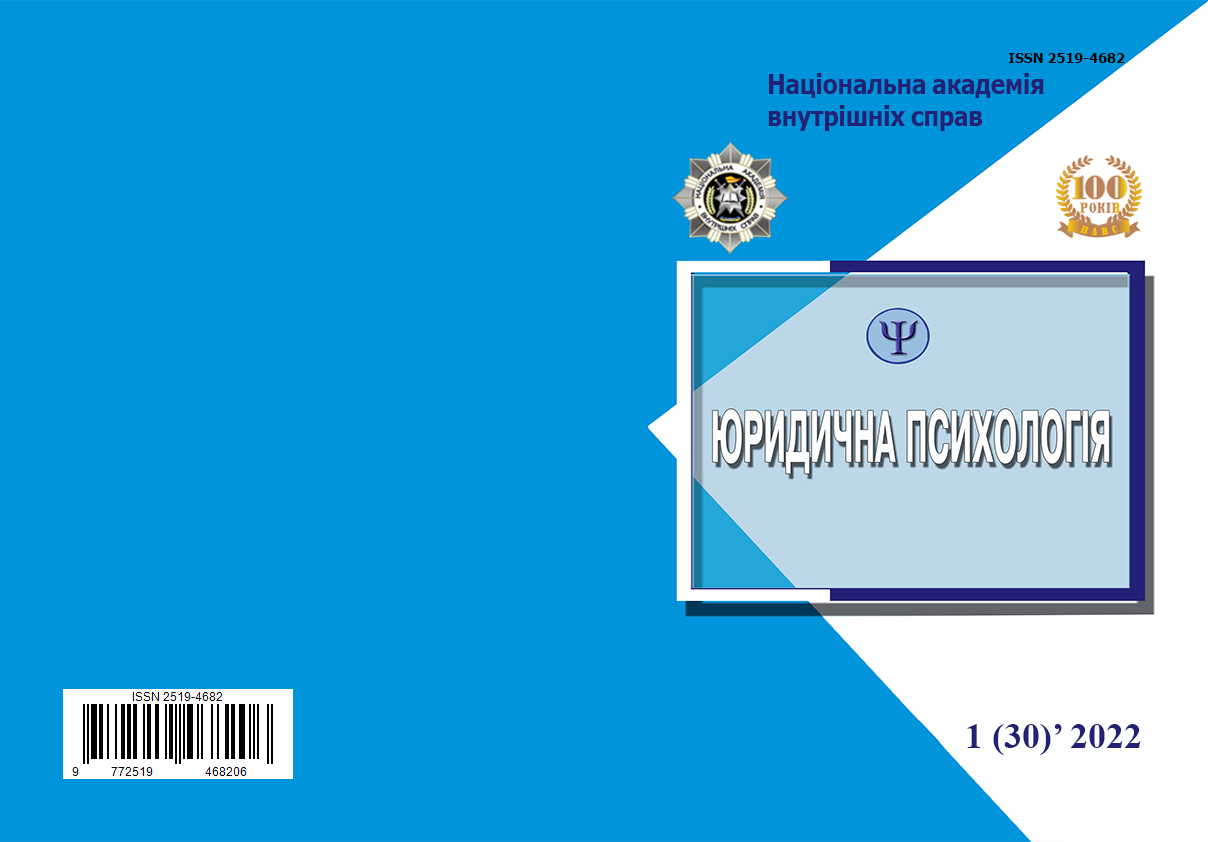Basic Self-Help Technologies in the Process of Psychological Practice
Abstract
Ways of helping themselves by psychologists and psychotherapists are still not structured and described in psychological science and practice. Although, there is a need for this, especially among psychologists of the system of the Ministry of Internal Affairs, the Armed Forces of Ukraine, the State Service of Ukraine for Emergency Situations and other departments. The purpose of the article is to describe scientific and practical recommendations on algorithms for the use of leading self-help technologies by psychologists in the process of psychological practice. The conducted scientific research made it possible to establish that psychologists and psychotherapists use certain psychotechnologies for self-help in such spheres of influence as bodily, bioenergetic, emotional and cognitive. Basically, these psychotechnologies are integrative, that is, they are aimed at several spheres of influence at the same time. The scientific novelty of the article is that I: for the first time: 1) conducted a survey of practical psychologists and psychotherapists regarding the psychotechnologies that they use in the process of psychological practice; 2) systematized psychotechnologies by spheres of influence; 3) four types of psychological activity of the "Helping those who help" direction (psychotherapy, supervision, advanced training and professional development, self-help) are identified and their main functions are determined; the algorithm for applying some exercises and techniques was further developed in accordance with modern realities and the achievements of psychological science. The practical significance of the article lies in the fact that the algorithms of self-help psychotechnologies described by us will contribute to: 1) increasing the level of professional development of psychologists; 2) prevention of professional burnout among psychologists; 3) normalization of their physical and mental state, etc.
Keywords: exercise; psychologist; psychotechnology; self-help; technique.
Downloads
References
Wojdylo K., Baumann N., Kuhl J. The Firepower of Work Craving: When Self-Control is burning under the rubble of self-regulation. PLoS One. 2017. No. 12 (1). doi: https://doi.org/10.1371/journal.pone.0169729.
Faramarz Ramzi, Omid Saed. The Roles of Self-Regulation and Self-Control in Procrastination. Psychol Behav Sci Int J. 2019. No. 13 (3). P. 555863. doi: 10.19080/PBSIJ.2019.13.555863.
Bertisch Meir R. Adopt a Psychologist: International Psychology Reporter. Washington, DC : American Psychological Association, 2005.
The heart and soul of change: Delivering what works in therapy / B. L. Duncan, S. D. Miller, B. E. Wampold, M. A. Hubble (Eds.). 2nd ed. American Psychological Association, 2010. doi: https://doi.org/10.1037/12075-000.
Kristin M. Vespia, Eric M. Sauer. Defining characteristic or unrealistic ideal: Historical and contemporary perspectives on scientist-practitioner training in counselling psychology. Counselling Psychology Quarterly. 2006. No. 19 (3). P. 229–251. doi: 10.1080/09515070600960449.
Kristin M. Vespia. Integrating professional identities: Counselling psychologist, scientist-practitioner and undergraduate educator. Counselling Psychology Quarterly. 2006. No. 19 (3). P. 265–280. doi: 10.1080/095150706009605554.
Novotney A. The therapist effect. Monitor on Psychology. 2013. Vol. 44. No. 2. P. 48.
Tsilmak O., Shcherbakova I., Berezka S., Formaniuk Y., Rudenko L., Mateiko N. Classification of Professionally Important Abilities and Skills of a Counseling Psychologist. BRAIN. Broad Research in Artificial Intelligence and Neuroscience. 2021. No. 12 (1). P. 363–377. doi: https://doi.org/10.18662/brain/12.1/187.
Beckmann J, Kellmann M. Self-regulation and recovery: Approaching an understanding of the process of recovery from stress. Psychol Report. 2004. No. 95. P. 1135–1153. doi: 10.2466/PR0.95.7.1135-1153.
Luszczynska A., Diehl M., Gutiérrez Doña B., Kuusinen P., Schwarzer R. Measuring one component of dispositional self-regulation: attention control in goal pursuit. Pers Indi-vid Dif. 2004. No. 37. P. 555–566.
Psychology of Self-Regulation: Cognitive, Affective, and Motivational Processes (1st ed.) / J. P. Forgas, R. F. Baumeister, D. M. Tice (Eds.). Psychology Press, 2009. doi: https://doi.org/10.4324/9780203837962.
Inzlicht M., Werner K. M., Briskin J. L., Roberts B. W. Integrating Models of Self-Regulation. Annual Review of Psychology. 2021. No. 72 (1). P. 319–345. doi: https://doi.org/10.1146/annurev-psych-061020-105721.
Чотири техніки саморегуляції, які допоможуть відновити емоційний ресурс URL: https://www.pedrada.com.ua/article/3018-chotiri-tehnki-samoregulyats-yak-dopomojut-vdnoviti-emotsyniy-resurs.
Семь-техник-визуализации. URL: https://4brain.ru/blog.
Антистрессовый комплекс упражнений. URL: https://osvita.ua/school/method/teacher/350.
Поняття саморегуляції. Способи саморегуляції. URL: https://sumy-gospital.lic.org.ua/novyny-2/poniattia-samorehuliatsii-sposoby-samorehuliatsii/.
Ліпинська С. Самодопомога. URL: https://switlipinska.com/uprazhneniya/microcourse-body-charge/.
Лоуэн А. Психология тела. Биоэнергетический анализ тел. URL: livelib.ru: https://www.livelib.ru/book/ 1000203567-psihologiya-tela-bioenergeticheskij-analiz-tela-a-louen.
Техніка «Заземлення 5-4-3-2-1». URL: http://www.cluber.com.ua/lifestyle/krasota-i-zdorove/2021/01/tehnika-zazemleniya-5-4-3-2-1-uprazhnenie-kotoroe-pomozhet-preodolet-trevogu/.
Упражнения для снятия стресса. URL: http://sosh5geo.ru/wp-content/uploads/.
Алёхин А. И., Метелева А. А. Методы саморегуляции психических состояний как способы борьбы со стрессом в современных условиях Молодой ученый. 2019. № 2 (240). С. 315–317. URL: https://moluch.ru/archive/240/55382/
Abstract views: 253 PDF Downloads: 695
- Authors reserve the right to authorship of their own work and transfer to the magazine the right of the first publication of this work under the terms of the Creative Commons Attribution License, which allows other persons to freely distribute published work with mandatory reference to authors of the original work and the first publication of an article in this magazine.
- Authors have the right to enter into separate additional agreements on non-exclusive dissemination of the work in the form in which it was published in the journal (for example, to post an article in the institution's repository or to publish as part of a monograph), provided that the link to the first publication of the work in this journal is maintained.
- The journal's policy allows and encourages the posting of articles by authors on the Internet (for example, in electronic storehouses of institutions or on personal websites), both before the submission of this manuscript to the editorial office and during its editorial processing, as this contributes to the creation of a productive scientific discussion and positively affects the efficiency and dynamics of citing the published work.




